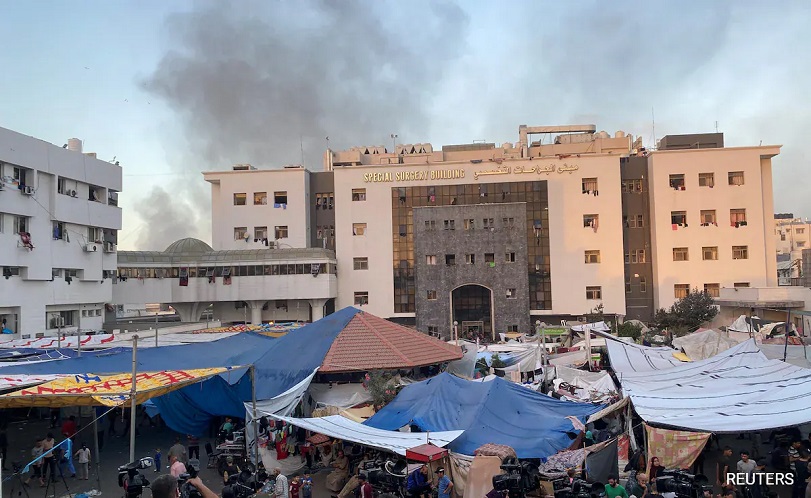
Gaza City, Palestinian Territories- Hundreds of makeshift tents stand in a desolate landscape at the foot of Gaza City’s ruined Al-Shifa hospital.
At least 30,000 people have taken refuge in its grounds between piles of rubble and waste after Israeli forces raided the medical facility last month, an AFP correspondent reported from the hospital.
Its medical equipment was heavily damaged and is now virtually unusable.
Food is scarce, too, but Gazans still come in search of what little safety a hospital — supposedly protected under international law — can afford as the shelling rumbles on.
AFP spoke to Gazans lacking everything from baby milk to tarpaulins for shelter from the rain and cold.
Mohammed Daloul arrived at Al-Shifa “with great difficulty” and described shelling and shooting around the hospital.
The 38-year-old, who fled with his wife and three children, said the artillery fire had not stopped for “several days”.
He was unable to take anything from his house in the ruined Zeitoun district of Gaza City’s old neighbourhood.
“Our life has become a living hell, there’s no electricity, no water, no flour, no bread, no medicine for the children who are all sick,” he told AFP.
“All we can think about is survival”, he said.
Hospital raid
The largest hospital in bombed-out Gaza had already been under immense strain in the first stages of the war, with bodies piling up after food, fuel and anaesthetics ran out.
But it became a major focus of the Israeli ground offensive, with Israel claiming that Hamas was running a command centre below the facility despite repeated denials from hospital officials and the Palestinian group.
On November 15, Israeli troops sparked international outcry by launching a night-time raid on Al-Shifa.
Several people, including the hospital director, were arrested and interrogated.
Israel invited journalists to visit a tunnel it said it had found beneath the complex, but what it achieved in the raid remained unclear.
More than two months into the war, the fighting has killed at least 17,997 people in Gaza, mostly women and children, according to the Hamas-run health ministry.
Hamas triggered the conflict with deadliest-ever attack on Israel on October 7 in which it killed some 1,200 people and seized some 240 hostages, according to Israeli officials.
‘Death will follow us’
An estimated 1.9 million of Gaza’s 2.4 million people — about 80 percent of the population — have been displaced, according to UN figures. Many are now in the south and running out of safe places to go.
Hundreds of thousands of displaced people are still believed to be in the heavily-bombed north.
On Saturday the Israeli army again told residents in the north to evacuate to safe areas — but international organisations have condemned the lack of areas free from bombardment in the narrow coastal strip.
Hospitals have been hit repeatedly. On Sunday, Gaza’s health ministry reported damage from a strike at the Jordanian field hospital in the southern city of Khan Yunis.
Gazans are desperate.
Souhail Abou Dhalfa said his family sought refuge at Al-Shifa after his 20-year-old son was wounded when their house was hit by relentless bombardment in Shejaiya, in the east of Gaza City.
“We put together a tent”, the 56-year-old said. “We don’t know if they will storm Al-Shifa again, and it doesn’t matter — wherever we go, death will follow us.”
Raed, who gave only his first name, has been sleeping on an old blanket under the stairs near the former emergency ward.
The 24-year-old’s family of nine has no money for a tent, he said.
His eight-year-old sister Manal sleeps with her head on a bundle of clothes.
Beside her, their mother keeps watch over a bottle of water, some bread and cheese. (AFP)
Follow this link to join our WhatsApp group: Join Now
Be Part of Quality Journalism |
Quality journalism takes a lot of time, money and hard work to produce and despite all the hardships we still do it. Our reporters and editors are working overtime in Kashmir and beyond to cover what you care about, break big stories, and expose injustices that can change lives. Today more people are reading Kashmir Observer than ever, but only a handful are paying while advertising revenues are falling fast. |
| ACT NOW |
| MONTHLY | Rs 100 | |
| YEARLY | Rs 1000 | |
| LIFETIME | Rs 10000 | |













